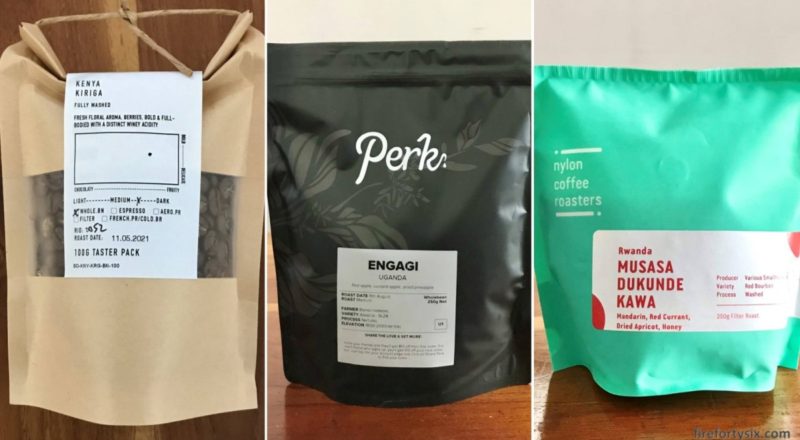Given that we’re such huge fans of Ethiopian coffee, it only made sense for us to compare it with those from other neighbouring countries in Eastern Africa.
But since I wasn’t familiar with African geography, I consulted my knowledgeable friend Dr GM, who suggested that I explore Kenya, Rwanda and Uganda.

Kenya
First up was Kenya, specifically the Kenya Kiriga from The Caffeine Peddler. It was part of a sampler pack and was the first one of eight that we tried. The tasting notes on the bag indicated a “fresh floral aroma, berries, bold and full-bodied with a distinct winey acidity”.

It made for a pleasant cup, with light floral notes coming through. Among the eight in the sampler pack, both The Wife and I ranked it at number two, with our respective number ones being two separate Ethiopians.
Ethiopia 1 : East Africa 0
Rwanda
Round Two *ding ding*. Entering the ring was the Rwanda Musasa Dukunde Kawa from Nylon Coffee Roasters, with its hint of “mandarin, red currant, dried apricot and honey”.

Red berries were prominent in the bright and well balanced cup, which tasted even better when paired with kway chap, the breakfast of champions!
Taste-wise, we both gave it a solid 8 out of 10, but when compared with the many Ethiopian beans we’ve had in the recent past, it came out slightly behind.
Ethiopia 2 : East Africa 0
Uganda
The third and final contender was the Uganda Engagi, a limited release from Perk Coffee and not part of their permanent selection. Tasting notes included not one, not two but three types of apple — red, custard and pine.

You might be thinking: “I’ve never heard of apples growing on pine trees!” and you would be right. But you must have heard of this tropical fruit called a pine-apple *ba dum tss*. Sorry, couldn’t resist.
Anyway, back to the coffee.
It wasn’t as fruity as indicated, and we couldn’t detect any of the three tasting notes, but it was a decent cup which grew on us the more cups we drank. Did we prefer it to Perk’s Ethiopia Yirgacheffe? Unfortunately, no.
So, final result after three rounds — Ethiopia 3 : East Africa 0, for a convincing win.
I’ve heard good things about Tanzanian coffee, but haven’t had the chance to try it out yet. I’ll definitely grab a bag the next chance I get, and complete my virtual tour of East Africa.
But until then, we’ll stick with our trusty Ethiopian beans, especially those from the highlands of Guji.

Just bought a pound of beans sourced from Jinotega, Nicaragua. They are naturally processed, grown at around 2,000 meters above sea level, light roasted, and claim notes of Blueberry, Tropical, and Candy-sweet. Really looking forward to trying them.
The cafe said the tasting profile is a little sweeter and less acidic than their Ethiopian Guji Highlands beans.
Sounds like it would make a great cup of coffee. Co-incidentally, I have a bag of Nicaragua queued up too; from Matagalpa region just south of Jinotega. Tasting notes say “starfruit, chocolate, melon, sugar cane”, which seems like an interesting combination. Enjoy your brew!
Just tried it this morning (pourover, Tetsu 4-6 method, Bright/Strong, 350ml water just off the boil to 20g coffee ground to Fine level 2 on Capresso Infinity). I vastly prefer the Ethiopian Guji Highlands beans to these.
While the Jinotega, Nicaraguan beans are very pleasant, I get no sweetness, acidity, or anything beyond just “hot, mild coffee”. It tastes like a coffee that would be very pleasing with eggs and toast, which is exactly what I’m about to make in order to round this out.
Well, that’s disappointing. I’ll get to my bag in a few weeks time and will update after. A local roaster was running a 50% sale and I probably bought too much ????
I adjusted my grind and brewing method today, and got a better result. I went to the smallest “fine” setting on my Capresso Infinity (there are 4 grind settings each for the categories Coarse, Medium, Fine, and Extra Fine, for a total of 16 grind settings), and used my Chemex instead of my triangular pourover. 50g coffee to 833g water fresh off the boil (makes enough for my wife and me to share in the morning), using the same Tetsu 4-6 Bright/Strong as last time. The result was a much more flavorful cup that was delicious both black (my preference) or sweet and creamy (my wife’s preference). The coffee’s natural flavor profile really came out this time.
I still prefer the Ethiopian Guji Highlands beans, but these are much better than I previously stated.
My thoughts: With this particular Nicaraguan light roast, grind finer than usual and use a brewing method that elongates the water’s contact time.
Tomorrow, I will try these beans with the James Hoffmann French press technique, to see if the extra elongated contact time helps.
I finally got round to brewing the Nicaragua beans from Finca la Virgen, roasted locally by Parallel Coffee Roasters. It was bright and tasty, with a pleasant citrus note that didn’t carry any unpleasant sourness. Both The Wife and I enjoyed it, but similar to you, we also prefer Ethiopian Guji beans over these. It’s also edged out by Colombian beans we’ve tried in the past.